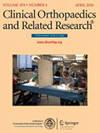Efficacy of Educational Presentations in the Pediatric Orthopaedics Clinic.
IF 4.2
2区 医学
Q1 ORTHOPEDICS
引用次数: 0
Abstract
BACKGROUND The patient education process is an important part of healthcare, and tools including handouts, videos, and webpage suggestions have been used to aid this process. Although educational slide presentations are commonly used for teaching in academic settings and have been used in certain specialty clinics, their use for educating families and improving the shared decision-making process has, to our knowledge, not been described in the orthopaedic surgery clinic. QUESTIONS/PURPOSES (1) How effective were educational PowerPoint presentations in the pediatric orthopaedics clinic as assessed by scores on a validated shared decision-making scale? (2) What were the families' preferred ways of learning about healthcare conditions? METHODS This prospective case series was conducted at an outpatient pediatric orthopaedic surgery clinic. Between May 2024 to January 2025, all new patients whose clinic visit was the initial visit for a single problem received an educational PowerPoint presentation specific to their diagnosis, delivered by the senior author (EDS) from a laptop. These presentations were developed for the top 10 most common diagnoses seen in the pediatric orthopaedic clinic. The presentation took on average 4 minutes to complete and outlined details of the diagnosis, natural history of the condition, treatment plan, and answers to frequently asked questions. Fifty-six patients with mean ± age of 11 ± 5 years were included in this study. The most common condition was scoliosis (52% [29 of 56]). After the clinic visit, the parents or guardians were given the Shared Medical Decision Making Satisfaction Scale, a validated tool that assessed their understanding of the diagnosis, ability to participate in shared decision-making, and perception of the visit. This survey included nine questions scored 1 to 5 or "not applicable" for a maximum score of 45. Higher scores indicated better understanding of the diagnosis and treatment options. Parents or guardians also ranked their preferred ways of learning from a list of four options, with options including educational presentation, verbal explanation, handout, or webpage suggestion. They were asked to draw from past experiences with the different modalities to compare to their experience with the provided educational PowerPoint. Fifty-six families completed the Shared Medical Decision Making Satisfaction Survey; 71% (40) of those families completed the ranking of preferred ways of learning, while the others left it blank for unknown reasons. A chi-square goodness-of-fit test was performed to determine which method of learning was preferred among parents or guardians. RESULTS Parents or guardians of the children treated generally gave the educational tool (the brief PowerPoint presentation about the child's condition) very high scores on the Shared Medical Decision Making Satisfaction Scale (mean ± SD 43 ± 4 of a possible 45 points, with higher scores representing the perception of a more engaging and satisfying process). Mean scores on all of the subscales of that tool exceeded 4.5 of a possible 5 points. When asked to compare their experience with the educational PowerPoint presentation to earlier experiences with verbal explanations, printed handouts, or web-based resources, the presentation was the preferred mode of receiving information; 60% (24 of 40) ranked this as the preferred approach, compared with verbal explanation (23% [9 of 40]), webpage suggestion (10% [4 of 40]), and printed materials (8% [3 of 40]) (p < 0.001). CONCLUSION Educational PowerPoint presentations seemed useful in delivering information to patients and families and in the facilitating of the shared decision-making process. Creating presentations for every diagnosis encountered in clinic is not feasible; however, presentations for the most common diagnoses may help to create a more effective practice. Further studies are warranted to investigate which slides are most effective, which healthcare information is best conveyed over PowerPoint for each diagnosis, and how reading level affects the ability of patients to understand the presentations. LEVEL OF EVIDENCE Level IV, therapeutic study.儿童骨科门诊教育演讲的效果。
背景:患者教育过程是医疗保健的重要组成部分,包括讲义、视频和网页建议在内的工具已被用于帮助这一过程。尽管教育性幻灯片演示通常用于学术教学,并已在某些专科诊所使用,但据我们所知,它们用于教育家庭和改善共同决策过程的用途尚未在矫形外科临床中得到描述。(1)在经过验证的共同决策量表上用分数来评估,教育性幻灯片演示在儿科矫形外科诊所中的效果如何?(2)家庭了解医疗状况的首选方式是什么?方法本前瞻性病例系列研究在一家儿科骨科门诊进行。在2024年5月至2025年1月期间,所有因单一问题首次就诊的新患者都收到了由资深作者(EDS)从笔记本电脑上提供的针对其诊断的教育性ppt演示文稿。这些介绍是针对儿科骨科诊所中最常见的10种诊断而开发的。报告平均耗时4分钟完成,并概述了诊断的细节、病情的自然病史、治疗计划以及常见问题的答案。56例患者平均±年龄为11±5岁。最常见的是脊柱侧凸(52%[29 / 56])。在诊所访问后,父母或监护人获得了共同医疗决策满意度量表,这是一个经过验证的工具,评估他们对诊断的理解,参与共同决策的能力和访问的感知。这项调查包括9个问题,得分为1至5分或“不适用”,最高得分为45分。得分越高表明对诊断和治疗方案的理解越好。家长或监护人还从四种选择中对他们喜欢的学习方式进行了排名,其中包括教育演示、口头解释、讲义或网页建议。他们被要求从过去使用不同模式的经验中得出结论,并与他们使用所提供的教育性幻灯片的经验进行比较。56个家庭完成了共同医疗决策满意度调查;这些家庭中有71%(40个)完成了首选学习方式的排名,而其他家庭则因不明原因没有填写。采用卡方拟合优度检验来确定家长或监护人更喜欢哪种学习方法。结果接受治疗的儿童的父母或监护人在共同医疗决策满意度量表上普遍给予教育工具(关于儿童病情的简短ppt演示)很高的分数(平均±标准差43±4分,满分为45分,分数越高代表对更有吸引力和满意的过程的感知)。该工具所有子量表的平均得分超过4.5分(满分为5分)。当被要求比较他们对教育演示文稿的体验与先前口头解释、打印讲义或网络资源的体验时,演示文稿是接受信息的首选模式;60%(40人中有24人)认为这是首选的方法,而口头解释(23%[40人中有9人]),网页建议(10%[40人中有4人])和印刷材料(8%[40人中有3人])(p < 0.001)。结论教育性ppt演示有助于向患者和家属传递信息,促进共同决策过程。为临床遇到的每一个诊断都创建报告是不可行的;然而,介绍最常见的诊断可能有助于创造一个更有效的做法。需要进一步的研究来调查哪些幻灯片最有效,哪些医疗保健信息最好通过PowerPoint传达给每个诊断,以及阅读水平如何影响患者理解演示的能力。证据等级:IV级,治疗性研究。
本文章由计算机程序翻译,如有差异,请以英文原文为准。
求助全文
约1分钟内获得全文
求助全文
来源期刊
CiteScore
7.00
自引率
11.90%
发文量
722
审稿时长
2.5 months
期刊介绍:
Clinical Orthopaedics and Related Research® is a leading peer-reviewed journal devoted to the dissemination of new and important orthopaedic knowledge.
CORR® brings readers the latest clinical and basic research, along with columns, commentaries, and interviews with authors.

 求助内容:
求助内容: 应助结果提醒方式:
应助结果提醒方式:


